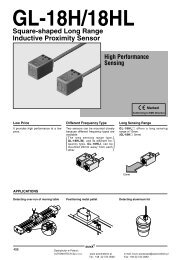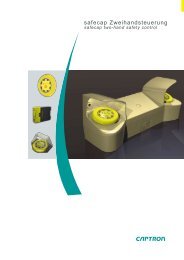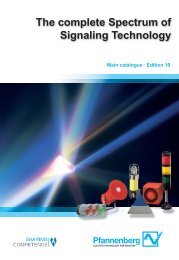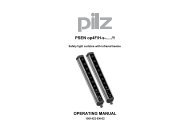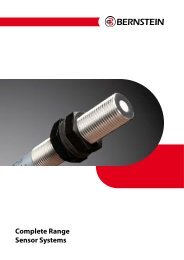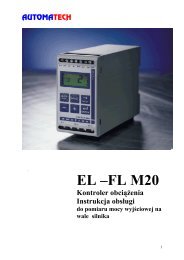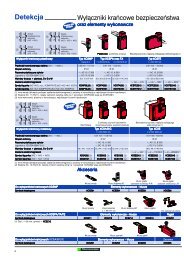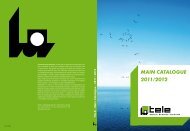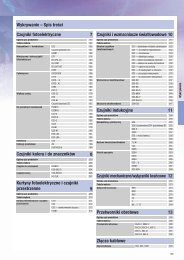Expansion modules - Automatech
Expansion modules - Automatech
Expansion modules - Automatech
You also want an ePaper? Increase the reach of your titles
YUMPU automatically turns print PDFs into web optimized ePapers that Google loves.
Standards and directives<br />
Risk parameters and categories in accordance with EN 954-1<br />
6.1<br />
2004-05<br />
6.1 Standards parameters and directives<br />
and categories in accordance with EN 954-1<br />
Risk parameters<br />
S = Severity of injury:<br />
1 = Slight (normally reversible) injury<br />
2 = Serious (normally irreversible) injury<br />
including death<br />
F = Frequency and/or exposure time<br />
to the hazard:?<br />
1 = Seldom to quite often and/or the<br />
exposure time is short<br />
2 = Frequent to continuous and/or the<br />
exposure time is long<br />
P = Possibility of avoiding the hazard:<br />
1 = Possible under specific conditions<br />
2 = Scarcely possible<br />
Starting point for<br />
risk estimation<br />
Risk graph from EN 954<br />
Categories in accordance with<br />
EN 954-1<br />
The control system requirements derived<br />
from the risk graph are specified<br />
as follows:<br />
Category B<br />
Basic category with no special requirements<br />
= “good industrial standard”<br />
Category 1<br />
Categories<br />
Categories<br />
Safety-related parts must be designed<br />
and constructed using well-tried components<br />
and well-tried safety principles.<br />
Well-tried means: the components<br />
have been widely used in the past with<br />
successful results in similar applications,<br />
or they have been manufactured<br />
using principles that demonstrate its<br />
suitability and reliability for safety-related<br />
applications.<br />
Example: safety switch with forcedopening<br />
contacts.<br />
Well-tried safety principles are circuits<br />
that are constructed in such a way that<br />
certain faults can be avoided by the<br />
appropriate arrangement or layout of<br />
components.<br />
Example: avoiding a short circuit<br />
through appropriate separation,<br />
avoiding component failures that result<br />
from over-dimensioning, using the<br />
failsafe principle (on switching off).<br />
Note: The occurrence of a fault can<br />
lead to the loss of the safety function.<br />
Category 2<br />
Safety-related parts of control systems<br />
must be designed so that their<br />
safety function(s) are checked at suitable<br />
intervals by the machine control<br />
system. The safety function(s) must be<br />
checked: at the machine start-up and<br />
prior to the initiation of any hazardous<br />
situation; periodically during operation,<br />
if the risk assessment and the<br />
kind of operation show that it is necessary.<br />
The initiation of this check may be automatic<br />
or manual. Automatically, for<br />
example, the check may be initiated<br />
by a signal generated from a control<br />
system at suitable intervals. The automatic<br />
test should be provided by preference.<br />
The decision about the type of<br />
test depends on the risk assessment<br />
and the judgement of the end user or<br />
machine builder. If no fault is detected,<br />
operation may be approved as a result<br />
of the test. If a fault is detected, an output<br />
must be generated to initiate appropriate<br />
control action. A second,<br />
independent shutdown route is required<br />
for this.<br />
Notes: In some cases Category 2 is<br />
not applicable because the checking<br />
of the safety function cannot be applied<br />
to all components and devices.<br />
Moreover, the cost involved in implementing<br />
Category 2 correctly may be<br />
considerable, so that it may make better<br />
economic sense to implement a<br />
different category.<br />
In general Category 2 can be realised<br />
with electronic techniques. The system<br />
behaviour allows the occurrence<br />
of a fault to lead to the loss of the safety<br />
function between checks; the loss<br />
of the safety function is detected by<br />
the check.<br />
Category 3<br />
Safety-related parts of control systems<br />
must be designed so that a single<br />
fault in any of these parts does not<br />
lead to the loss of the safety function.<br />
Whenever reasonably practicable, the<br />
single fault shall be detected at or before<br />
the next demand upon the safety<br />
function.<br />
This does not mean that all faults will<br />
be detected. The accumulation of undetected<br />
faults can lead to an unintended<br />
output signal and a hazardous<br />
situation at the machine.<br />
Category 4<br />
Safety-related parts of control systems<br />
must be designed so that a single<br />
fault in any of these parts does not<br />
lead to a loss of the safety function;<br />
the single fault must be detected at or<br />
before the next demand upon the<br />
safety functions (e.g. immediately at<br />
switch on, at the end of a machine operating<br />
cycle).<br />
If this detection is not possible, then<br />
an accumulation of faults shall not lead<br />
to a loss of the safety function.<br />
6.1-6<br />
Pilz GmbH & Co. KG, Sichere Automation, Felix-Wankel-Straße 2, 73760 Ostfildern, Germany<br />
Telephone: +49 711 3409-0, Telefax: +49 711 3409-133, E-Mail: pilz.gmbh@pilz.de<br />
2004-05



